Extended Warranty Income:
If comparing extended warranty to net income is misleading, then let's correct the record by comparing apples to apples: warranty claims paid to recognized revenue over the past two years.
Reaction to the Oct. 26 edition of Warranty Week was decidedly negative. In that edition, we compared the recognition of extended warranty revenue to net income at eight well-known companies.
They're totally different things, one subscriber said. It's not even like comparing apples to oranges. It's more like comparing apples to applesauce.
What we were attempting to show was how profitable extended warranty sales are, and how extended warranties account for a significant portion of certain manufacturers' net income. But it's not as simple as computing extended warranty recognized revenue as a percentage of net income. First of all, recognized revenue is pre-tax and net income is after-tax. Even if pre-tax operating income is used instead, as it was for a few of the eight examples in the Oct. 26 edition, it's still not proper accounting, the subscriber said.
Another subscriber called to say that in his opinion, extended warranties couldn't be that profitable. They couldn't be that big a source of profits for most companies because if they were, everybody would be selling them. How could some companies keep it secret for so long that they're making more money off service contracts for the products they sell than they are on the products themselves? If this were true, one would assume that all the hordes of stock analysts following these manufacturers would have picked up on this. Yes, one would assume. The sad fact is that nobody has, except the people selling extended warranties, and they're a bit camera shy.
A longtime reader at one of the eight subject companies actually cancelled his subscription last week. Perhaps it was a signal of protest? If it was, we're going to send him this edition, apologize for making an inappropriate comparison last time, and try again to make the point using the same data in a different way. The data wasn't untrue, but the comparisons were perhaps a bit unfair. And perhaps the tone of the article suggested that extended warranty profits were somehow embarrassing. It's not embarrassing. But it is surprising.
Importance of Extended Warranty Revenue
The point of the Oct. 26 edition was to show how important extended warranties have become to some of the manufacturers who sell them. There are other ways to do that than to compare revenues to profits. For one thing, several of the companies mentioned in that article were unprofitable over some segment of the last 21 months, so the comparison didn't work. For another thing, profits fluctuate at rates much greater than anything seen in warranty. So perhaps net income was the wrong choice.
This time around, we're going to make the same point about the importance of extended warranties to OEMs by comparing the amount of revenue recognized from the sale of service contracts to the amount of reported warranty claims. Granted, there's even problems with this approach, because some companies don't separate claims into two components as perhaps they should: one for product warranty claims and another for extended warranty claims. But the last thing we want to do is conclude that analysis is impossible because the data isn't perfect.
So let's take a second look at four companies: Apple Computer Inc.; Dell Inc.; Gateway Inc.; and Eastman Kodak Co. And let's compare product warranty and extended warranty in two ways for each. In the first chart for each company, we'll simply list the reported dollar amounts for warranty claims (in red) and extended warranty recognized revenue (in blue). In the second chart, we'll put those reported dollar amounts on a scale of 100%, where a reading of 50% for each would result if the dollar amounts were exactly equal.
Outflows vs. Inflows
What we're doing is comparing the outflow of funds used to pay claims to the inflow of funds derived from extended warranty policy premiums. For some companies, they're roughly equal, meaning essentially that extended warranty buyers are financing warranty claims, more or less. For other companies, they're radically out of equilibrium, suggesting perhaps that either a company is pushing too hard or not hard enough when it comes to offering extended warranties.
Let's start with Dell Inc. As the chart below suggests, the company is spending roughly as much on product warranty (red) as it sells in extended warranties (blue). HTML Edition readers who want the data in tabular form can click here to request the Plain Text Edition of this week's column. Plain Text Edition readers who want to see the graphs are directed to http://www.warrantyweek.com/newsarchive/ww20041109.html for an online version of this article.
Dell Inc.
Product Warranty Claims
Extended Warranty Revenue
in $ Millions per Quarter
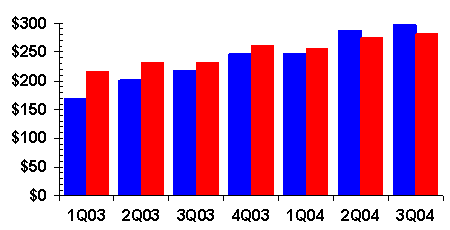
Source: Warranty Week from SEC data
The red and blue bars aren't always exactly equal, but they've been awfully close during the past four quarters. Interestingly, it was six months ago that extended warranty became the bigger component. This is better seen in the chart below, where the 50% line is drawn in black.
Dell Inc.
Product Warranty Claims
Extended Warranty Revenue
in Relative Size
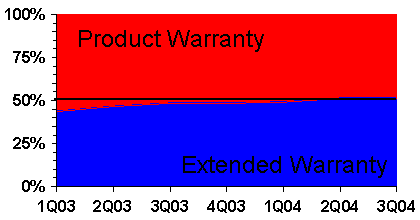
Source: Warranty Week from SEC data
What this chart shows is that for Dell, extended warranty revenue has gradually overtaken warranty spending over the last seven quarters. One is essentially paying for the other. That would seem to be the ideal case.
Next comes Apple Computer Inc. During the first calendar quarter of 2003 the company recognized $6 million in extended warranty revenue and reported $17 million in warranty claims. In the first quarter of 2004, both figures had grown to $12 and $27 million, respectively. The AppleCare Protection Plan is a hot item, with sales of service contracts up 100% year over year. But because of warranty problems with batteries and screens, claims were up 60% over the same period.
Apple Computer Inc.
Product Warranty Claims
Extended Warranty Revenue
in $ Millions per Quarter
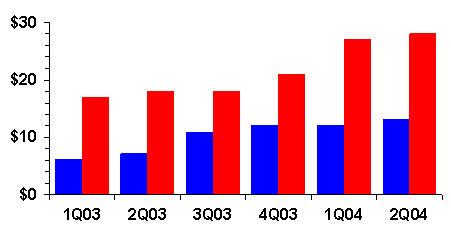
Source: Warranty Week from SEC data
The trend is clearly up for both. Extended warranty revenue is increasing faster than claims, so the ratio is now drifting close to the 33% mark, up from 26% last year. It's been as high as 37%, and it will be again after claims from the iPod and G4 subside.
Apple Computer Inc.
Product Warranty Claims
Extended Warranty Revenue
in Relative Size
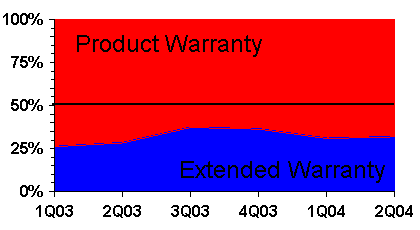
Source: Warranty Week from SEC data
Now let's look at a company that really changed its status. You've heard of swing states. This is a swing company. Gateway Inc. has cut warranty costs and boosted extended warranty sales at the same time, turning around a situation where claims costs used to consume 6% or more of sales revenue (it's now closer to 2%). Those are the tall red bars in the chart below. They've been shrinking in size for the last five quarters.
Gateway Inc.
Product Warranty Claims
Extended Warranty Revenue
in $ Millions per Quarter
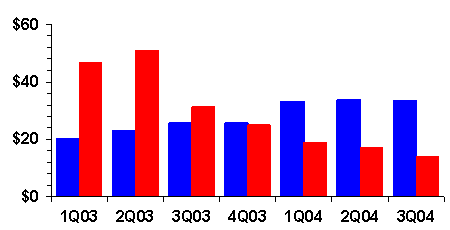
Source: Warranty Week from SEC data
Whatever manufacturing or warranty problem the company was having in early 2003, it's behind them now. Warranty costs have plunged from near $50 million per quarter to more like $15 million per quarter. At the same time, extended warranty recognized revenue has grown from $22 to $33 million. Keep in mind that overall Gateway is running at a net loss. So even moreso than for profitable companies, cutting costs and boosting high-margin sales are crucial to the bottom line.
The swing is more visible on the graph below. The ratio has rather cleanly flipped, from 70/30 a year ago to 30/70 now. Gateway crossed the 50% line in the fourth quarter of 2003.
Gateway Inc.
Product Warranty Claims
Extended Warranty Revenue
in Relative Size
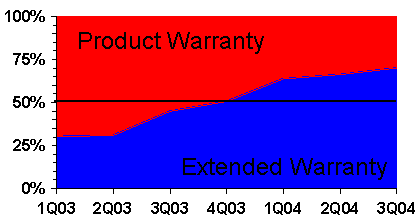
Source: Warranty Week from SEC data
It's not like crossing the equator. There's no party or anything. But it's a significant milestone when a company crosses the 50% mark. From that point onwards, warranty is a profit-generating enterprise. How profitable depends on what one believes to be the loss ratio of extended warranties. From discussions with industry sources, it seems to be in a range of 20-30%, with auto extended warranties towards the low end and PC warranties toward the high end of that scale. We'll get more into that in a future article.
Let's look at one more company, the Eastman Kodak Co. In the Oct. 26 edition, it was detailed how Kodak's extended warranty recognized revenue frequently exceeded total income. Now let's look at the same data in a different way.
The charts above detail how product warranty and extended warranty are more or less in equilibrium at Dell, of growing importance to Apple, and a radically good change of fortune for Gateway. Now take a look at Kodak.
Eastman Kodak
Product Warranty Claims
Extended Warranty Revenue
in $ Millions per Quarter
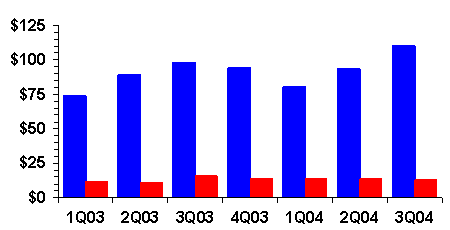
Source: Warranty Week from SEC data
Extended warranty recognized revenue is 6 to 8 times as much as warranty claims. There's no other case like this. If there is, please email the editor. There are actually numerous companies at the other extreme, where extended warranty is an underachiever, bringing in a small fraction of what's paid in claims. But for Kodak, it's the opposite. The buyers of Kodak's extended warranties are paying for the company's claims and covering its net loss in manufactured product sales.
Eastman Kodak
Product Warranty Claims
Extended Warranty Revenue
in Relative Size
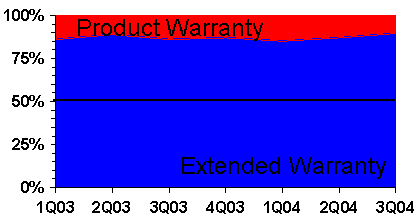
Source: Warranty Week from SEC data
There are roughly a dozen major manufacturers who sell extended warranties but don't disclose those finances in their 10-Q or 10-K forms. We're going to make some assumptions for them. For OEMs that sell extended warranties, good is when the ratio hits 25% between claims and extended warranty revenue. Great is when it crosses the 50% mark. Outstanding is 70%. Unbelievable is when it gets close to 90%. By those standards, Apple is good, Dell is great, Gateway is outstanding, and Kodak is unbelievable.









